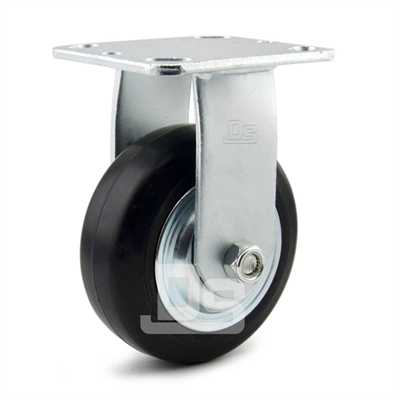Rigid caster wheels are a fundamental component used to provide stability and controlled movement in various applications. Here are the basics of rigid caster wheels:
- Definition: Rigid caster wheels are wheels or sets of wheels mounted on a frame or housing that allows an object or equipment to move in a straight line without swiveling. They do not have the ability to pivot or change direction independently, which makes them ideal for applications requiring stability and a fixed path of movement.
- Components: Rigid caster wheels typically consist of the following components:
- Wheel: The wheel is the circular part that makes contact with the ground. It can be made of various materials, including rubber, polyurethane, nylon, or metal, depending on the application’s requirements.
- Fork or Mounting Plate: The wheel is attached to a fork or mounting plate, which connects the wheel to the equipment or object being moved.
- Axle: The axle is a rod that passes through the center of the wheel and is attached to the fork or mounting plate. It allows the wheel to rotate around the axle.
- Load Capacity: Rigid caster wheels are designed to support and move objects with specific weight capacities. The load capacity depends on the size and material of the wheel and the construction of the caster. It’s essential to choose caster wheels with an adequate load capacity for your application to ensure stability and safety.
- Wheel Material: The choice of wheel material is crucial and depends on the application. Common wheel materials include:
- Rubber: Provides good shock absorption and traction, making it suitable for indoor use on smooth surfaces.
- Polyurethane: Offers durability, resistance to wear, and is suitable for both indoor and outdoor applications.
- Nylon: Known for its high load-bearing capacity and resistance to chemicals, making it suitable for heavy-duty industrial applications.
- Metal: Metal wheels, such as steel or cast iron, are exceptionally strong and are used for heavy loads in demanding environments.
- Size: Caster wheels come in various sizes, and the choice of size depends on the application and load capacity requirements. Larger wheels can distribute weight more effectively and provide better mobility over uneven surfaces.
- Mounting Options: Rigid caster wheels can be mounted using various methods, such as plate mounting, stem mounting, or bolt hole mounting. The choice of mounting method depends on the equipment or object being used and the desired level of stability.
- Braking Mechanisms: Some rigid caster wheels come with integrated brakes, allowing you to lock the wheel in place when needed. This is particularly useful for applications where the object needs to remain stationary at times.
- Maintenance: Rigid caster wheels typically require less maintenance than swivel casters because they have fewer moving parts. However, regular cleaning and inspection are essential to ensure smooth and safe operation.
- Applications: Rigid caster wheels are commonly used in applications where stability and a straight-line path are essential, such as industrial carts, dollies, assembly line equipment, heavy machinery, and other scenarios discussed in previous responses.
When choosing rigid caster wheels for your application, it’s important to consider factors such as load capacity, wheel material, size, and the specific requirements of your use case to ensure that the wheels provide the necessary stability and controlled movement.


